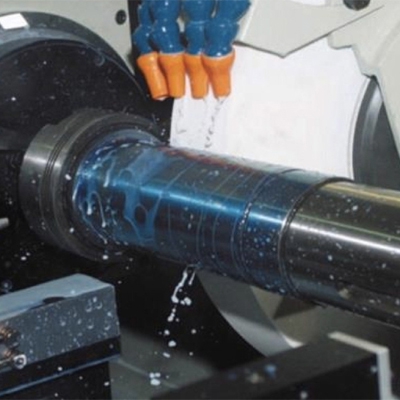
Innovative new software from NUM enables CNC machine tool builders and retrofitters to provide their customers with exceptionally easy-to-use work piece programming and machine control facilities for precision grinding applications.
Forming the latest application-specific addition to NUM’s Flexium CAM suite of CNC software, the new NUMgrind package simplifies machine tool programming for an extensive range of tasks, including external and internal cylindrical grinding, surface grinding, wheel shaping and dressing.
NUMgrind is specifically designed to simplify the creation of G code programs for CNC machine tools through the use of a highly intuitive graphical human machine interface (HMI), conversational-style ‘fill in the blanks’ type dialogs or a combination of the two. Unlike conventional CAD/CAM workstation tools for generating CNC machine tool control programs, NUMgrind is intended for use in the production environment. It enables shop floor personnel to handle everyday machining tasks such as grinding very quickly and efficiently – and the work can be easily shared amongst several people and several machines.
NUMgrind works in conjunction with embedded CNC grinding and dressing cycles and direct hyperlinks to several production files such as wheel/part data sheets, CAD files and/or other pertinent grinding production data to facilitate efficient manufacturing of a diverse range of workpieces, covering various different wheel forms and part types. It can be configured for a wide variety of machine configurations such as OD/ID Grinders, Surface Grinders, Centerless Grinders, etc.
The cylindrical grinding package includes OD/ID grind cycles for 2-Axis (X/Z) horizontal or vertical grinding machines and also offers an inclined axis capability. The dressing station can be table-mounted or rear-positioned to accommodate a wide range of machines. Standard forms or profiled wheels can be dressed with single point, double point or roller dresser. For surface grinding, NUM offers full grinding cycles for 3-Axis (X/Y/Z) machine configurations with built-in wheel dressing capabilities similar to that of the OD/ID cylindrical grinding package.
Machine production time is very efficient due to HMI pages that guide the machine operator through a step-by-step process in setting up the machine for each part. Standard dresser setup and part setup cycles prompt the user to jog the axes to specific locations on the machine in order to teach the dresser and part zero program positions. These cycles enable the user to quickly and easily calibrate their machine for a wide variety of parts and wheels.
As soon as the data entry session is complete, the program is generated automatically, stored, and made ready for execution. The result is a modular, easily modifiable program that will produce the desired grind process.
In conjunction with NUMgrind, Flexium 3D (NUM’s graphical simulation software) provides the operator with another very useful tool to further enhance productivity. Once a part program is generated through NUMgrind CAM, the operator can simulate the grinding cycle through Flexium 3D. The software can be configured in a variety of different ways to match many standard cylindrical and surface grinding machines. It can be used directly at the machine or as a standalone program for grinding process verification. This software gives the operator more power to ensure that the generated programs match their desired outcome before grinding occurs on the machine.
Related Glossary Terms
- computer numerical control ( CNC)
computer numerical control ( CNC)
Microprocessor-based controller dedicated to a machine tool that permits the creation or modification of parts. Programmed numerical control activates the machine’s servos and spindle drives and controls the various machining operations. See DNC, direct numerical control; NC, numerical control.
- computer-aided design ( CAD)
computer-aided design ( CAD)
Product-design functions performed with the help of computers and special software.
- computer-aided manufacturing ( CAM)
computer-aided manufacturing ( CAM)
Use of computers to control machining and manufacturing processes.
- cylindrical grinding
cylindrical grinding
Grinding operation in which the workpiece is rotated around a fixed axis while the grinding wheel is fed into the outside surface in controlled relation to the axis of rotation. The workpiece is usually cylindrical, but it may be tapered or curvilinear in profile. See centerless grinding; grinding.
- dressing
dressing
Removal of undesirable materials from “loaded” grinding wheels using a single- or multi-point diamond or other tool. The process also exposes unused, sharp abrasive points. See loading; truing.
- grinding
grinding
Machining operation in which material is removed from the workpiece by a powered abrasive wheel, stone, belt, paste, sheet, compound, slurry, etc. Takes various forms: surface grinding (creates flat and/or squared surfaces); cylindrical grinding (for external cylindrical and tapered shapes, fillets, undercuts, etc.); centerless grinding; chamfering; thread and form grinding; tool and cutter grinding; offhand grinding; lapping and polishing (grinding with extremely fine grits to create ultrasmooth surfaces); honing; and disc grinding.
- grinding wheel
grinding wheel
Wheel formed from abrasive material mixed in a suitable matrix. Takes a variety of shapes but falls into two basic categories: one that cuts on its periphery, as in reciprocating grinding, and one that cuts on its side or face, as in tool and cutter grinding.
- shaping
shaping
Using a shaper primarily to produce flat surfaces in horizontal, vertical or angular planes. It can also include the machining of curved surfaces, helixes, serrations and special work involving odd and irregular shapes. Often used for prototype or short-run manufacturing to eliminate the need for expensive special tooling or processes.
- surface grinding
surface grinding
Machining of a flat, angled or contoured surface by passing a workpiece beneath a grinding wheel in a plane parallel to the grinding wheel spindle. See grinding.






